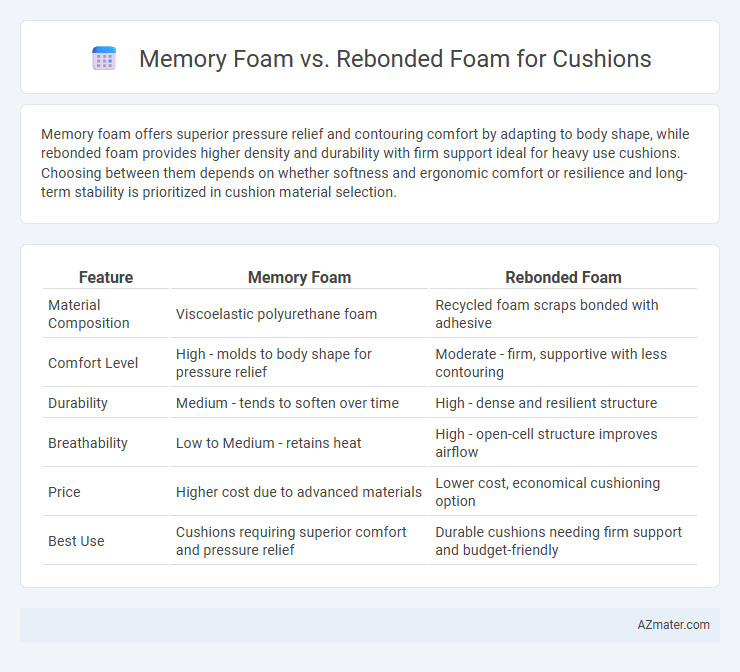Memory foam offers superior pressure relief and contouring comfort by adapting to body shape, while rebonded foam provides higher density and durability with firm support ideal for heavy use cushions. Choosing between them depends on whether softness and ergonomic comfort or resilience and long-term stability is prioritized in cushion material selection.
Table of Comparison
| Feature | Memory Foam | Rebonded Foam |
|---|---|---|
| Material Composition | Viscoelastic polyurethane foam | Recycled foam scraps bonded with adhesive |
| Comfort Level | High - molds to body shape for pressure relief | Moderate - firm, supportive with less contouring |
| Durability | Medium - tends to soften over time | High - dense and resilient structure |
| Breathability | Low to Medium - retains heat | High - open-cell structure improves airflow |
| Price | Higher cost due to advanced materials | Lower cost, economical cushioning option |
| Best Use | Cushions requiring superior comfort and pressure relief | Durable cushions needing firm support and budget-friendly |
Introduction to Cushion Foams
Memory foam offers superior contouring and pressure relief by responding to body heat and weight, making it ideal for cushions focused on comfort and support. Rebonded foam, composed of shredded foam pieces bonded together, provides dense durability and firmness suited for heavy-duty or high-traffic cushion applications. Understanding the differences in foam composition, resilience, and cushioning properties is essential for selecting the right material based on usage and comfort preferences.
What is Memory Foam?
Memory foam is a viscoelastic polyurethane foam known for its excellent pressure-relieving properties and ability to conform to body shape, providing superior comfort and support in cushions. It reacts to heat and pressure, allowing customized cushioning that reduces pressure points and enhances ergonomic support. Memory foam cushions are popular in furniture and bedding for their durability and ability to evenly distribute weight.
What is Rebonded Foam?
Rebonded foam is a high-density material made by shredding and bonding scrap polyurethane foam pieces with adhesive, resulting in a firm and durable cushion core ideal for heavy-use furniture. Unlike memory foam, which contours to body shape for pressure relief, rebonded foam provides a resilient, supportive base that maintains shape over time without significant compression. This makes rebonded foam especially suited for seating applications requiring long-lasting support and firmness at a more affordable price point.
Key Differences Between Memory Foam and Rebonded Foam
Memory foam offers superior contouring and pressure relief by responding to body heat and weight, making it ideal for personalized comfort in cushions. Rebonded foam, composed of shredded foam pieces bonded together, provides higher density and durability, resulting in firmer support and long-lasting resilience. While memory foam excels in softness and adaptive cushioning, rebonded foam is preferred for robust support and cost-effectiveness in commercial or heavy-use applications.
Comfort and Support Comparison
Memory foam cushions offer superior contouring and pressure relief by adapting to body shape, providing personalized comfort and targeted support. Rebonded foam cushions deliver firmer support with enhanced durability, ideal for users seeking a resilient, dense cushioning experience. The choice between memory foam and rebonded foam depends on whether comfort-driven pressure distribution or long-lasting, firm support is prioritized.
Durability and Longevity
Memory foam cushions offer superior durability due to their closed-cell structure, which maintains shape and provides consistent support over time, typically lasting 7 to 10 years. Rebonded foam, made from shredded foam pieces bonded together, is less resilient and prone to faster deterioration with frequent compression, reducing its longevity to around 3 to 5 years. Investing in high-density memory foam enhances cushion lifespan by resisting permanent deformation and promoting better load distribution.
Breathability and Heat Retention
Memory foam cushions offer superior contouring and pressure relief but tend to retain heat due to their dense cell structure, which limits breathability. Rebonded foam cushions provide enhanced airflow with their open-cell construction, promoting better breathability and reduced heat buildup, making them cooler for extended use. Selecting between the two depends on prioritizing temperature regulation with rebonded foam or body-conforming comfort with memory foam.
Cost Analysis: Memory Foam vs Rebonded Foam
Memory foam cushions typically cost more due to their advanced viscoelastic properties, which provide superior comfort and pressure relief. Rebonded foam, made from shredded scrap foam bonded together, offers a more budget-friendly option with good durability but less contouring ability. The cost difference reflects the trade-off between high-performance memory foam's premium price and rebonded foam's economic value in cushion manufacturing.
Best Uses for Each Foam Type
Memory foam offers superior contouring and pressure relief, making it ideal for cushions used in ergonomic chairs, office seating, and mattresses that require enhanced comfort and support. Rebonded foam, known for its high density and durability, is best suited for heavy-duty applications such as industrial seating, gym mats, and high-traffic furniture where resilience and firmness are essential. Choosing memory foam enhances personalized comfort, while rebonded foam provides long-lasting structural integrity in demanding environments.
Which Foam Should You Choose for Cushions?
Memory foam offers superior contouring and pressure relief, making it ideal for cushions that prioritize comfort and ergonomic support. Rebonded foam, composed of recycled foam pieces bonded together, provides durability and firm support, suitable for heavy-use or budget-conscious cushions. Choosing between memory foam and rebonded foam depends on your need for softness and body-conforming qualities versus resilience and cost-effectiveness in cushion performance.

Infographic: Memory foam vs Rebonded foam for Cushion
 azmater.com
azmater.com